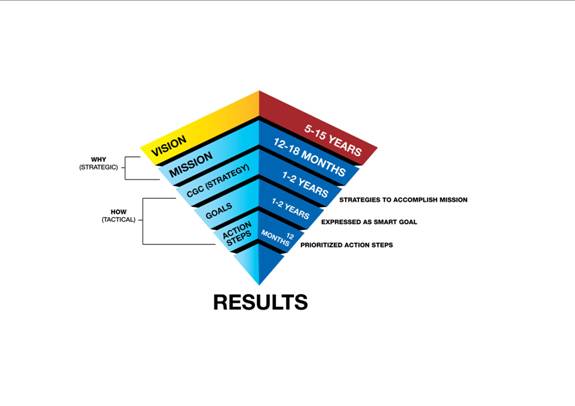Business plans don’t have to be long to be good. A single page can contain all of the essential elements you need to tell your employees, board of directors, potential partners, or banker where you are taking your business and how you are going to get there. It does, however, need to be thorough and contain all of the necessary elements to insure your firm’s success. Peak’s methodology will begin with education on the Strategic Planning process and will engage your team with the proper members at the appropriate segments. Along the way, the Peak team will employ its methodology to draw out the needs for your company. Peak’s consultants will utilize various tools to develop and define all of the elements of a well crafted Strategic Plan. These will include the following:
- Brainstorming
- Roundtable Discussions
- Strengths, Weaknesses, Opportunities and Threats Analysis
- 100 Point Exercise
- Quick ROI Analysis
The key elements to a successful plan include the following:
Vision Statement
The place where you describe your view of what the company will become. Vision statements should be expansive and idealistic. They should stimulate thinking, communicate passion and paint a very graphic picture of the business you want.
Mission Statement
The mission statement describes the purpose for which your product or business exists. Great mission statements are short and memorable. They communicate in just a few words the company’s focus and what is being provided to customers. Mission statements answer the questions of – What business are we in? and How do we want to be in it?
Internal and External Analysis
Strategic Planning is information intensive. In order to establish strategies and objectives, it is necessary to understand the environment in which the firm operates. This is accomplished through a SWOT analysis. That is, Strengths, Weaknesses, Opportunities and Threats are identified. Plan development can then continue to maximize the Strengths and Opportunities and to eliminate or minimize Weaknesses and Threats.
Strategies
Strategies set the direction, philosophy, values and methodology for building and managing your company. Strategies also establish guidelines and boundaries for evaluating important business decisions. Strategies determine the “what” in the mission statement. In addition, they determine how you will be different from your competition.
Objectives
Objectives clarify what it is you are trying to accomplish. They are specific, measurable, attainable, realistic and time oriented. In other words, they are well-defined targets with quantifiable elements that are measurable. Objectives will support a specific strategy.
Action Plans
These are the specific actions the business must execute to achieve the objectives. Action items should be important, significant and contribute to the growth of the business. Each action plan is in effect a project. Ideally each plan should directly relate to an objective and strategy.
Financial Projections
One to five year Profit and Loss Statement
One to five year Balance Sheet
One to five year Cash Flow Statement (sources and uses of funds)
Key Performance Indicators
Based on the objectives, strategies and action plans of the business, these are the metrics for determining successful attainment of the plan. Inventory Turns, Days Outstanding in Accounts Receivable, Order Cycle Time and Man Hours per Unit of Output are examples of metrics that can be used.
|

